For Chinese New Year 2023, we’re celebrating a collaboration between Raby Castle and two Postgraduate students from the University of Durham. Beini Wu and Lingqiao Zhang were on a Museum and Artefact Studies course, and as part of their placement at Raby, built on our understanding of the history and culture surrounding our Chinese porcelain collection.
A tradition of collecting
Historically, the British nobility has a long tradition of collecting. With financial backing, antiquities and artworks came to Britain from all over the world, and these items became a symbol of status and taste.
The popularity of the Chinese style in Britain reached a peak in the mid-18th century. These products were seen as exotic and intriguing, representing both a new stimulus and an ancient civilization. Europeans also used East Asian elements in their own creations: Dutch Delft Blue pottery and German Meissen both replicated Chinese porcelain, and the imitation of lacquer finish and concept of ‘japanning’ were popular in furniture designs.
Raby and China
Raby Castle has a rich collection of Chinese and Japanese artefacts, ranging from porcelain to furniture and furnishings, and from Chinese and Japanese exports to British imitations. The earliest pieces can be traced back to porcelain made in the Kangxi period of the Qing Dynasty (late 17th to early 18th century.) The latest ones include contemporary work made by a young artist from Jingdezhen, China in 2017.
The collection is mostly export porcelain, including Blanc de Chine (white Chinese porcelain), Blue and White, Famille Vert (Chinese porcelain with green as the dominant colour) and Famille Rose (Chinese porcelain with pink colour enamel). Most export porcelain of the Qing dynasty was produced in the province Guangdong, or sent to Guangdong for colouring, and were catered to the taste of Western collectors at the time.
The ‘Chinese porcelain’ collection at Raby Castle, especially those from the 17th and 18th centuries, are a combination of Chinese, Japanese, and Western aesthetic elements. The pieces below highlight the collection at Raby Castle and explore the owners’ fascination with Chinese and Japanese art and styles, from the Vane family to the present day.
Highlights of the collection
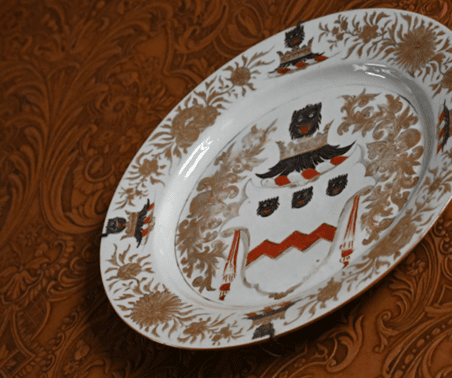
Pulteney crested plates
Produced in 1720, these unassuming Armorial dishes are some of the oldest Chinese pieces in the collection. Armorial ware, or heraldic china, are ceramics decorated with a coat of arms. The ones at Raby bear the arms of the Pulteney family, whose vast fortune was inherited by the Vanes through marriage. The plates were originally hung in Bath House, the London home of the Earls of Bath, before being inherited and brought to Raby by William Harry, 3rd Earl of Darlington (later the 1st Duke of Cleveland) in 1807.
Armorial porcelain was first produced in the 16th century and was a key export. The UK alone imported more than 4,000 different styles of Armorial Porcelain from China. These were specially commissioned by individuals and families, and exporters would specify in detail the varieties, wares and size required.
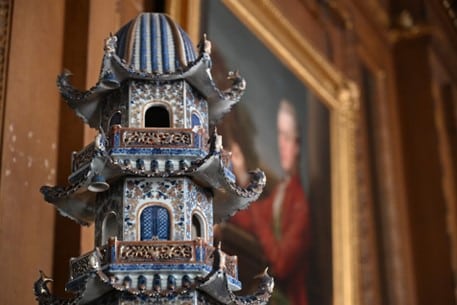
The pagoda was originally a stone or brick structure designed to store Buddhist relics and sutras (canonical scriptures). Upon the spread of Buddhism into China, these were combined with traditional wooden pavilions and developed into a large structure visitors could walk around. Bells were often hung from the eaves of the pagoda, clearing the mind and driving away evil… and more practically being used to deter birds.
These two hexagonal porcelain pagodas were specially made for export. A set was first ordered from China by the Prince of Wales (later Prince Regent and George IV) between 1803 and 1804, and there are still six of them in the Royal Pavilion in Brighton.
The pair at Raby Castle have eight storeys, with real and false doors on each. The body is in blue and white, while the base is famille rose. They are similar to the two smaller pagodas in the Royal Pavilion, and were probably made at the same time.
The fish-shaped component on the corner of the pagoda is a mythical Chinese animal ‘chiwen,’ who had a dragon’s head and a fish’s tail. Most traditional Chinese buildings are wooden, so images of fish and dragons were a symbol of protection against fire.
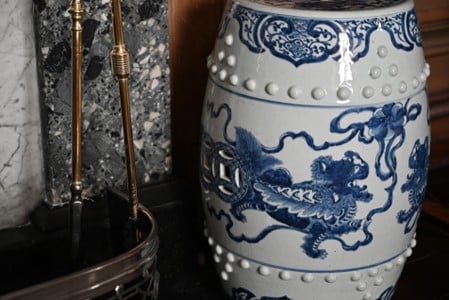
In blue and white porcelain, cobalt oxide is used as the raw material for decoration, which is then covered with a transparent glaze and fired over a high-temperature reduction flame. The cobalt is a vivid blue after firing. During the Ming and Qing dynasties, blue and white became the mainstream porcelain.
Raby’s barrel-shaped porcelain stool- originally used for sitting outdoors- is painted with a pattern of lions playing with balls. The various motifs on Chinese porcelain and furniture are not only decorative, but have different auspicious meanings. The lion pattern is symbolic of good fortune and good weather. As a result, lion dances have been performed at major festivals throughout China’s history. This custom was represented in paper-cutting, stone and wood carvings, and was first used in ceramics during the Song dynasty (960-1276).
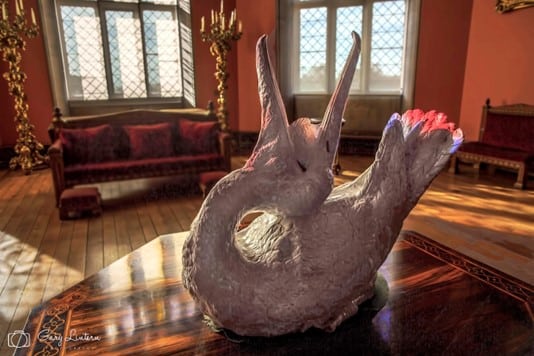
The transfer of Chinese porcelain to the West not only influenced artistic styles, but also brought with it Chinese ceramic production techniques.
In the early 18th century, a French missionary shared information about the art of glazing and firing in Jingdezhen (known as the ‘Porcelain Capital’) to Europe, greatly enlightening the European porcelain industry. In 1708, Europeans also discovered kaolin- a type of clay used for porcelain. In 1710, Meissen porcelain was successfully produced, signifying the birth of Europe’s first porcelain factory. The white porcelain animals in Baron’s Hall are some of Meissen’s earlier works.
When producing the large Pelican, the modeller faced a variety of technical challenges. All five existing copies have several fire cracks on the bottom edge of the walling. The bird is seen sitting with its’ head tilted to rest on its back; the posture was partly for practical reasons, with the body being used to support the weight of the pelican’s head.
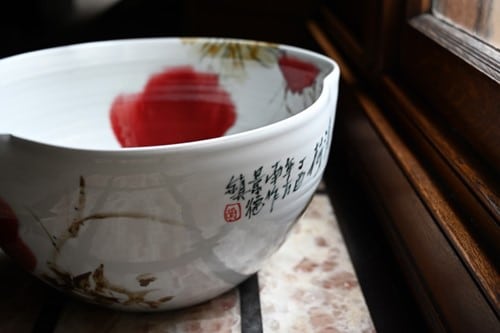
Raby’s love of the Chinese style continues to this day. In the entrance corridor are two pieces recently purchased by the current owners, one of which is a large begonia bowl from China. The inscription on the bowl indicates that its name is ‘Fresh lotus,’ and was made in Jingdezhen by Fang Nan in Ding You (2017). Ding You is a year in the sixty-year cycle of traditional Chinese chronology.
Fang Nan, formerly known as Ning Fengying, was born in 1979 in Jingdezhen into a family of ceramicists. She studied high-temperature kiln-glaze painting with her father as a child and has continued to innovate over the past thirty years, specializing in colour glazes.
The begonia bowl was popular mainly from the late Tang to the Southern Song dynasties in China (about 750-1280) and was named after its’ four-petal mouth, which was shaped like a begonia flower. The lotus flower is a common subject in traditional Chinese painting and has been loved by literati (Chinese scholar-officials) throughout the ages for its ‘undefiled’ character. The piece combines modern ink painting techniques with traditional porcelain styles.
See if you can spot our Chinese porcelain dotted around the castle when we re-open on 1st March 2023.

